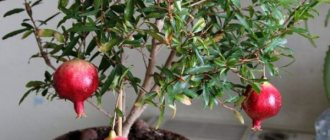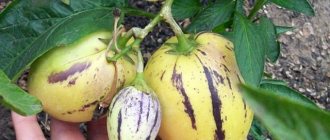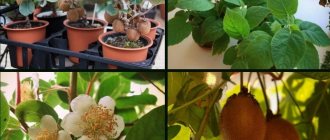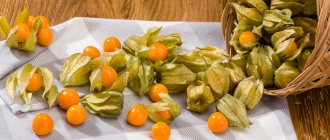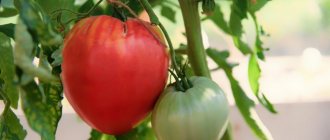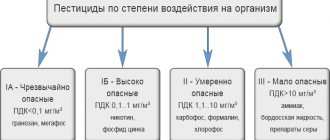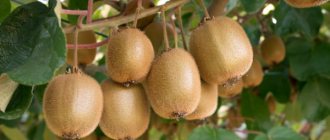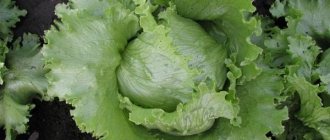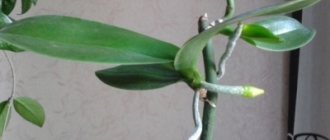Some people believe that there are no perfect creatures in the world around us. This may be true, but if you look in detail at how pomegranate grows, it is easy to disprove this theory. The majestic exotic tree has exquisite beauty, unsurpassed fertility and valuable properties. Its bright red fruits resemble small lights that can provide warmth on harsh winter days. Looking at them, you involuntarily remember the sultry summer in the southern regions and the charming colors of exotic resorts. Despite this, many people do not think about how the majestic pomegranate grows in nature and whether it can be grown at home.
Description of the plant
The pomegranate tree is a shrub of the loosestrife family. The fruits of the bush are popularly called “pomegranates,” but their official name is “pomegranates.”
Where and how does it grow?
The homeland of pomegranate is the Middle East. The plant is grown in Iran and Pakistan. Pomegranate also grows in the Caucasus. The pomegranate tree reaches 10-15 m in height and bears fruit for 40-50 years.
Countries growing pomegranate for export: Crimea, Italy, Greece, Georgia. In some Russian cities, the pomegranate tree is not uncommon - for example, in Sochi.
How does it bloom?
Residents of northern countries, who know about pomegranate only as a tasty juicy fruit, as a rule, have no idea how this exotic plant blooms and grows. Pomegranates sprout from “jugs”. The “jug” can be female or male. The male bud is cone-shaped, while the female bud is rectangular. Scarlet or white flowers sprout from the bud.
Pomegranate flower
Fruit or berry?
Looking through children's books with the names of plants, you may accidentally notice that pomegranate is classified as a “fruit,” although sometimes you can also find such designations as “berry.” Fruit is a purely culinary concept, because the fruit of the plant is juicy and sweet in taste. In botany, it is customary to use the word “berry”.
A plant is called a fruit in everyday life, and a berry in botany and botanical communities. Not only pomegranate, but also banana, watermelon, kiwi, etc. can be considered a berry.
A short excursion into the distant past
Some associate the first mention of the unique fruit with Adam, when he violated the Creator’s commandment. Unfortunately, the Holy Scriptures do not say which fruit was the cause of man’s sin. Despite this, the stories of ancient Greek myths and the healing methods of ancient doctors are associated with it.
In view of these facts, it is quite difficult to say where the pomegranate tree was first discovered, because today the culture can be found in many parts of the planet. It is grown in North Africa, Italy, Spain, Azerbaijan and Turkey. The fruit is popular in the valleys of the Caucasus Mountains. He has fans in Abkhazia and sunny Georgia. There are many places in Russia where pomegranate grows. This is the southern part of the Krasnodar Territory, the Crimean Peninsula and the Azov region. Enterprising gardeners are trying to grow new cold-resistant species in mid-latitudes and even in the Moscow region.
Since pomegranate is considered a valuable storehouse of useful substances, it aroused interest even during the reign of the Egyptian pharaohs and Roman Caesars. Interestingly, when the Phoenician city of Carthage was captured by the Romans, only pomegranate trees survived. After which the fruit began to be called the “king” of exotic fruits. In addition, at its top stood a majestic crown of sepals, which became the prototype of the royal crown. The photo provided shows how a pomegranate grows on the branches of an exotic tree.
Translated into Russian, pomegranate means “grainy apple,” which recalls its beneficial properties for health. Truly a valuable “casket” of precious microelements and vitamins.
Health benefit or harm
Any fruit is certainly good for health, but only if consumed correctly and combined with other foods. Pomegranate can cause an allergic reaction if consumed in excess.
Beneficial properties for a woman’s body
Women are recommended to regularly consume pomegranates, since the fruit contains vitamins necessary for the functioning of the female body:
- retinol – strengthens the immune system, helps cure skin diseases;
- folic acid – affects the hematopoietic process during the menstrual cycle;
- vitamin C – protects cells from aging, improves metabolism;
- nicotinic acid is vitamin B3, which takes part in numerous processes in the body.
It is believed that pomegranate seeds benefit a woman’s body: they protect against the development of breast cancer. However, there is no exact evidence for this.
For pregnant
The benefits and harms of pomegranate for the health of pregnant women are determined depending on whether the woman has a tendency to allergic reactions. Folic acid provides beneficial properties of pomegranate during pregnancy. It protects the expectant mother’s body from premature birth and also prevents fetal rejection. Pomegranate seeds also eliminate swelling of the hands and feet.
For men
The benefit of pomegranate for the male body lies in its biostimulating function. Being a vitamin concentrate (primarily C and group B), this fruit reduces the level of oxidative stress, thereby preventing the development of diseases associated with age-related changes.
Harvesting and storing pomegranates
In southern Russia (in some regions of Kuban) and Crimea, fruits begin to be harvested in October.
Harvesting pomegranates At this time, they reach maximum ripeness, the grains are full of sugars, and the peel acquires a rich red or yellow-pinkish speckled color.
When fully ripe, pomegranate fruits may crack; if you collect them for storage, you need to catch them before this moment.
Fully ripe pomegranates may crack
Pomegranate stores well and remains fresh for a long time.
Pomegranate stores well and stays fresh for a long time
Fruits cannot be stored at sub-zero temperatures, otherwise they may rot. A ventilated room with an air temperature of +2 °C will be optimal.
Benefits of pomegranate juice
“Grainy apple” juice is a concentrated drink, so you can drink no more than 300 ml per day. Benefits of pomegranate juice:
- a mix of vitamins and amino acids allows you to maintain your immune system at its best;
- strengthening nails, teeth and hair;
- stabilization of blood pressure.
Pomegranate juice is not only beneficial, but can also be harmful to health:
- due to the acids contained, it stimulates appetite;
- teeth may darken;
- the appearance of a skin rash is possible.
The main thing is to observe moderation.
Usage
Pomegranate ranks first in iron content and increases blood hemoglobin. Therefore, it is recommended as a natural medicine for anemia, anemia, and chronic fatigue. Additionally, it is used as follows:
- Juices and vinegar are made from grains;
- culinary component of dishes for the preparation of sauces and desserts;
- peel containing calcium, potassium, magnesium, zinc, selenium, serves as raw material for the production of medicines;
- the dried peel is used in traditional medicine;
- cosmetic use of the juice will stop skin aging;
- flowers, partitions are brewed, infused, and used as medicinal decoctions.
Pomegranate is not only a tasty low-calorie fruit, but also a valuable product containing useful amino acids, vitamins, and minerals.
How to use peels to your advantage?
Pomegranate peel has both beneficial properties and contraindications. The peel can be applied to wounds and scratches for quick healing. Pomegranate pericarp also helps with diarrhea and other intestinal disorders.
The peel of the berry contains 5% alkaloids, and these substances are toxic to the body. Therefore, the peel must be poured with boiling water before use. Take the decoction 4 times a day, a teaspoon. Within 2-5 days of consuming a decoction of the peel, the functioning of the gastrointestinal tract and intestines is normalized. At the same time, the skin is cleansed and the complexion improves.
A decoction of pomegranate peel can be taken to get rid of worms. You can also fill the crust with cold water. In this case, the drink should be allowed to brew for at least 6 hours. Pumpkin seeds and garlic against parasites.
Useful properties of the magic pomegranate “casket”
Since ancient times, people have noticed a number of beneficial properties of the royal fruit. Its berries are filled with many vitamins, mineral salts and trace elements. The juice contains a huge amount of amino acids, tannins, glucose and sugar.
Exotic pomegranate fruits have a beneficial effect on the immune system, blood vessels and blood pressure. Quench thirst, stimulate appetite and lower blood sugar. The inflorescences of the royal fruit contain an abundance of dyes, therefore they are widely used in light industry. Decoctions from the peel are drunk for intestinal disorders, as a fixative. Also used for gargling and various inflammatory processes.
Truly, pomegranate is an indispensable fruit for the whole family. It’s not too late to start growing it and get a lot of pleasant emotions.
How to choose in the store?
Pomegranate is a capricious plant, which is why during export it is necessary to resort to various chemical additives so that the fruit does not lose its taste and visual appeal. Recommendations for those who buy exotic fruits in stores:
- Choose heavy fruit. The more it weighs, the more grains it contains, and, accordingly, the more juice.
- Look for the “crown” on the top of the head. This is a sign that the fruit is ripe enough to eat.
- Uniform peel color. Gray or brown spots are a sign that the fruit is rotting from the inside.
Before you start choosing grenades, you should pay attention to the store. It is advisable to buy live products at a specialized point - fruit or vegetable. The condition of exotic fruits in hypermarkets is rarely checked, which is why there is a risk of purchasing a beautiful wrapper with a rotten “filling”.
Reproduction
Growing a pomegranate bush from a seed is very simple, but an individual does not always inherit the parental qualities. From the seeds of a large and sweet fruit you can get seedlings with fruits that cannot be consumed. Therefore, it is worth purchasing harvested seedlings at specialized sales points.
When choosing seedlings, it is worth considering that the following varieties are best suited for growing at home:
- Crimean striped, which has large dark red fruits and a thin peel. Such fruits ripen quite early.
- Gyulosha pink is a variety bred in Turkmenistan. It has large, oval light pink fruits with a thin skin. Their ripening period is average.
So, pomegranate is suitable for growing organic fruits at home. And its flowering bush will delight you with a pleasant aroma.
How to clean it properly?
Almost everyone peels pomegranates the same way: cut them into two halves, remove the peel and squeeze out the seeds.
This is not entirely correct. Firstly, it takes a lot of time, and secondly, this can damage the pulp. Residents of southern countries, where the “grainy apple” is a common fruit, recommend peeling pomegranates as follows:
- Carefully cut off the “cap” of the fruit.
- Divide the pomegranate along the contours of the white pulp into 4-5 parts (the contours of each fruit may be different).
- Break the fruit along the “marked” contours.
This way, the pomegranate will be divided into beautiful pieces that can be served on the table. This method preserves the integrity of the grains and prevents juice leakage.
Origin and historical homeland
Scientists claim that the pomegranate, about which the peoples of the East and West made up legends, was mentioned in the works of healers, was cultivated at least 4 thousand years ago. The ancient Romans and Greeks presented the fiery red fruit of the plant, which was called the Carthaginian apple, as a gift to the gods, revered as a symbol of fertility, the flower was personified with passionate love. Researchers suggest that the homeland of the pomegranate is Persia, but before our era, cultivated forms of the low, spreading tree were cultivated in Asia Minor and Central Asia, in Transcaucasia, from where the plant reached the Mediterranean.
Wild pomegranate is found in northern Africa, Afghanistan, the Middle East, and southern Europe. Sailors brought the fruits, inside of which many seeds are formed, to the New World, and the plant began to be cultivated in the subtropics of America, on numerous islands scattered across the Pacific Ocean and the Caribbean.
Is it possible to eat pomegranate with seeds?
As a child, everyone was told: “Don’t eat pomegranates with seeds, otherwise you’ll get appendicitis!” Those whose parents were more creative were afraid that a pomegranate tree would begin to grow in their stomachs, the branches of which would “climb” through the nose and ears. The behavior of parents is quite reasonable - they are worried about the health of their children, but do they explain the reason correctly? What are pomegranate seeds good for and can they be consumed raw?
Pomegranate seeds can only be consumed in ground form. They should not be chewed due to the high probability of causing defects to the teeth. Swallowing whole grains is also not recommended: this can lead to intestinal obstruction, since whole grains are not digestible by humans.
Grain without pulp is a complex carbohydrate and fiber. Passing through the gastrointestinal tract, the crushed bone cleanses the body and intestines. Bones absorb toxins and saturate the body with beneficial microelements: vitamins, vegetable fats, polyunsaturated acids.
How pomegranates grow in summer cottages
At your dacha, you can grow a useful and beautiful plant without much difficulty. How to grow pomegranate? Choose a sunny, extensive area . For planting, dig a hole 60 cm wide, high, and deep. Place a couple of shovels of fertile soil at the bottom of the hole.
Then they place a seedling on it, bury it and water it generously, compacting the planting site. There should be no voids formed. A day later, the pomegranate is watered again. The ground is sprinkled with old sawdust or leaves to retain moisture.
Oily clay soil is mixed with sand before planting . Sandy soil, on the contrary, is diluted with chernozem.
It is recommended to lower the seedlings into a hole ten centimeters lower than the plants were planted in the nursery. Then it’s better for the grenade to grow. During the first year, plants require special care . Neither humus nor additional fertilizers are applied so as not to destroy the young pomegranates. However, in the first year, fertilizing will still be required. The best option is “Crystalon”. It will speed up the flowering and growth of the seedling. Fertilizer is applied by foliar method.
Features of care
Fruiting directly depends on the seedling. If layering or cuttings are used, you will have to wait at least six years. Moreover, weaker plants grow from lignified cuttings. Strong seedlings produce a harvest in the third year after planting. Maximum fruiting occurs after eight to ten years.
Be sure to monitor the soil, promptly ridding it of growing weeds. In autumn the plant is covered. At the same time, the branches are tilted down, attached to pegs, and then sprinkled with earth.
Trim? Necessarily!
In the spring or after harvesting, scheduled pruning is carried out. Old branches are cut out, damaged, small, leading to thickening of the crown.
- Be sure to remove root growth. There is no point in growing it.
- 5-6 shoots are left on the tree. This will improve fruiting well and allow the plant to be well covered for the winter.
- Once every 20 years, anti-aging pruning is carried out.
How many calories are in a pomegranate?
Pomegranate is a dietary product that accelerates metabolism and cleanses the body. The calorie content of pomegranate is determined based on the weight of the fruit, its variety and degree of ripeness.
White garnet
Calories with seeds in 100 grams?
Calorie content of 100 grams of pomegranate is up to 80 kcal. The nutritional value of pomegranate seeds is low: 1.6 g of protein and up to 5 g of fiber, the rest is water and biologically active substances. For this reason, pomegranate juice has almost the same calorie content as grains - about 60 kcal per 100 g.
In 1 piece
Considering that pomegranates are quite large (sometimes they barely fit in the palm of your hand), many are tormented by the question: “Is it harmful to eat a whole pomegranate for your figure?” One fruit weighs 500-600 grams. Calorie content 1 pc. A pomegranate with seeds, not counting the weight of the peel and “partitions,” is up to 400 kcal!
Indoor version of an exotic plant
Consummate fans of the royal fruit even know the secret of how to grow pomegranate at home and collect fruits from it. Dwarf plant varieties are suitable for this purpose; they begin to bloom in the second year after planting.
In order for the tree to successfully take root, you will need a small container. It must be wide so that the surface roots of the plant develop well. The soil is slightly acidic. If you follow these simple rules, it is not at all difficult to grow an indoor pomegranate with a maximum height of 1.5 meters. It just takes a little patience and effort.
There are several ways to plant an exotic potted fruit:
- ready-made seedlings from the nursery;
- germinated material from gardening companies;
- cuttings;
- bones.
The easiest way to grow a pomegranate tree is to purchase it from a nursery. Gardeners who patiently grow pomegranates from seeds at home get much more pleasure.
They start by selecting planting material. Only seeds from fully ripened fruit that are free of any blemishes are suitable. It is advisable to find a pomegranate from an indoor tree, then you are more likely to grow the fruit.
The ripe fruit has a dryish skin that fits tightly to the grains. If it has a shiny character, it means that the fruit was picked unripe. Such bones will not work.
The selected pomegranate should be quickly peeled and dried for 24 hours. Before planting, the seeds are soaked in milk, water or growth stimulants. The seeds are placed in the prepared loosened soil to a depth of 1 cm and covered with plastic wrap. After approximately 20 days, shoots appear. Now you can remove the film.
Since growing a pomegranate from a seed is quite difficult, several factors should be taken into account:
- the container with the plant should be placed on a well-lit window;
- at first, protect from direct sunlight;
- As the top layer of soil dries out, water regularly with clean water;
- the permissible room temperature is not lower than 12 degrees.
When the tree grows, flowers of an original shape will appear on it. Over time, they will turn into royal fruits, inside of which juicy seeds are stored. They are, of course, smaller in size than imported grenades, but the value of the product remains unchanged.
In order for the tree to fit harmoniously into the interior, it is advisable to adjust the shape of the crown once every 6 months. Typically, pruning is done in spring and autumn, removing excess shoots. The soil under the plant should always be slightly moist. In summer, the pot is taken outside or to the balcony to speed up the growth process. When cold times come, it is brought into the house where the tree spends the winter.
The maximum temperature for a “sleeping” plant is no higher than 15 degrees. There is no need to feed it in winter. Water sparingly as the soil dries out. With the arrival of spring, young leaves appear on the pomegranate tree. Now it can be fed to stimulate growth.
Initially, it is advisable to plant the pomegranate in a small pot that corresponds to the size of the earthen ball near the roots of the seedling. The tighter the container, the more abundantly the dwarf pomegranate tree blooms.
How to use for weight loss?
Many diets include this plant, as it perfectly cleanses the body and eliminates hunger for a long time. How to lose weight on pomegranates:
- The duration of the diet is 5-7 days (no more!).
- Breakfast – 100 ml of pomegranate juice (freshly squeezed, not store-bought!). You can snack on an apple.
- Lunch: 100 ml of pomegranate juice, boiled chicken or egg, steamed vegetables.
- Dinner: 50-100 ml of pomegranate juice, low-fat cottage cheese or kefir.
For lunch, instead of meat, you can eat chopped baby food: broccoli, chicken, stew, etc. Baby food does not contain sugar or chemical additives, thanks to which the body will quickly digest the food, and the kilograms will disappear before your eyes. In 5-7 days of the pomegranate diet, 5 kg are lost.
The fruit can also be used to prevent weight gain. It is not necessary to change your diet. It is enough to stop eating white sugar, trans fats, processed foods and fast food. It is recommended to drink freshly squeezed juice immediately after waking up and before each meal. In this way, the body will receive a sufficient amount of useful microelements, start metabolism, and the absorbed food will be digested more thoroughly.
Warning! Under no circumstances should you go on a “pure” pomegranate diet. If, in addition to juice, you do not eat anything for a week, the stomach will be irritated and gastrointestinal diseases may develop. To avoid health problems, you should dilute the concentrated juice with drinking water. This will not reduce the amount of vitamins, but the effect of the drink on the walls of the stomach will be more gentle.
Growing as a cover crop
Pomegranate grows and blooms in any soil, even rocky and sandy. The culture does not get along only in saline and swampy areas. The fruit survives drought much better. Besides, he even “loves” her. The place where the fruit is planned to be planted must be well lit, because any shadow negatively affects the fruit. Individuals should also be protected from cold northern winds. On poor soils it is better to follow a 4x2 planting pattern, and on fertile soils - 5x2 or 5x3, which will help the bushes and trees grow more powerful.
When growing pomegranate at home, you should dig a hole 0.6 meters wide, long and deep and at its bottom place a 10-centimeter layer of grass and the top (most fertile) layer of soil. Next, place the bush in the “hole”, deepening it another 0.1 meters lower than it grew before, and cover it with clay soil with the addition of sand. Experienced gardeners advise planting pomegranates at an angle of 45°. Indeed, in this way, the plant will form many additional roots, which will increase the strength of the bush and its productivity. In addition, such a bush is easier to cover in winter.
It is worth noting that it is unacceptable to introduce fertilizers of any nature into the pits intended for planting individuals.
In the area of the root system, the soil must be compacted and filled with water so that there are no voids left between the soil. Moistening is repeated the next day, and the ground around the planting is mulched with sawdust or mown grass (a layer of at least 0.1 meters).
Watering should be done in case of urgent need, but not more often than weekly. In the first year of life, fertilizers are applied foliarly on green leaves in May and June. It is advisable to use fertilizers of a mineral nature (in no case organic). It is permissible to add Crystalon in an amount of 2 grams per liter of water per bush. The soil is treated superficially to avoid damage to the roots located close to the surface. In the second spring of the plant’s life, you should pour half a bucket of manure under the bush. The procedure must be repeated every year.
Contraindications for use
Is pomegranate good or bad? In the debate about whether pomegranate is beneficial or harmful to the body and human health in general, the second option may win if you consume the fruit when medical indications strictly prohibit it. These include:
- Increased sensitivity of teeth.
- Stomach ulcer.
- Increased acidity, heartburn.
- Irritated esophagus.
- Frequent constipation.
Concentrated juice should not be given to young children (0 to 5 years old). Give the freshly squeezed drink to children aged 6 to 10 years with great caution.
Biological characteristics
It is customary to say “pomegranate tree”. However, not all gardeners agree with this definition, rightly considering the plant to be a bush. There is no unambiguous definition of the plant form of pomegranate. Indeed, even in the relevant specialized literature, culture is defined as a tree-bush. Pomegranate grows in several shoots emanating from one root, which is the leading characteristic of the bush. However, you can successfully grow fruit in one trunk, that is, in the form of a tree.
The pomegranate tree has a powerful root system that reaches great depths in the soil. The plant quickly takes root in a container, so it needs frequent (annual) replanting.
In unprotected soil, the plant can reach a height of 3 to 5 meters, and individuals grown at home - about 1.5 meters. There are also so-called dwarf varieties, which are usually used as indoor plants.
The pomegranate has a false berry type fruit. It is usually round or oval. The size ranges from a 2-centimeter diameter for domestic varieties to a 12-centimeter diameter intended for human consumption. The weight of one fruit ranges from 0.2 to 0.5 kilograms.
The pomegranate tree is considered to be a long-lived plant - at home it can live for about half a century and consistently bear fruit. In nature, even hundred-year-old individuals can bear fruit. Some recognized centenarians are even about 300 years old.
Pomegranates ripen gradually on the tree, so you need to harvest them in stages, keeping an eye on the color of the skin. When the air temperature drops, the leaves fall off. However, individuals growing at home behave like evergreens. But it is still recommended to create a dormant period for the plant, not allowing it to bloom until March (plucking the flowers).
Pomegranate is a plant of the subtropics, where, even in severe winter, the air temperature does not drop below 10°C. However, an adult can easily withstand even 15-degree frost without shelter. But still, the crop should at least be sprinkled with soil for the winter.
Can it be grown at home?
A pomegranate tree in the garden is the dream of many summer residents. In the south it is easier to grow such a tree than in central and northern Europe. Shrubs are planted by cuttings. Planting requires a loose peat substrate, sand and soil in a drainage container. Seeds sprout within 2 weeks. The cutting is a two-year-old branch grown in a pot. Its height should be 15-20 cm. After the branches have been grafted, the young shrub is transplanted into “open” ground, where the future tree will grow.
Growing in tubs
For growing in tubs, the plant can be formed as a standard with 5 skeletal branches or a bush with 4 trunks. In this case, the height of the plant should be 0.5 - 0.6 meters. Old dry shoots are eliminated in May.
Particular attention should be paid to shoots growing inwards. After the crop sheds its leaves, the tub is placed in a cold cellar.
Chemical treatments are not needed for pomegranate, since in our territories the plant is not exposed to diseases and pest attacks.
Planting seedlings in a permanent place
The time must be chosen at the end of April or in May, when the temperature will be around 12-13 degrees Celsius.
Step-by-step description of planting in a permanent place:
- Dig a hole in the ground 80 centimeters deep and 60 centimeters in diameter.
- Install several pegs for further gartering of the bush.
- Place a ten-centimeter layer of gravel or broken brick on the bottom of the hole.
- Sprinkle soil and fertile soil on top.
- Next, place humus mixed with sand there. The entire mixture should reach the edge of the hole.
- Place the seedling on top of the resulting mound and straighten the roots.
- Cover the top with soil.
- Tie the plant to the stakes, compacting the soil a little. The seedling should be on a small oval hill.
- Water.
Transplanting a plant into the ground
Varieties of pomegranate
Avocado from the seed - growing at home
There are not many varieties of this plant. Mainly:
- Wild Socotra, growing on the island of Socotra. It is not used in any way in terms of culture.
- Standard, grown in Western Asia, Mediterranean. It has many subspecies; there are both cultivated and wild specimens.
- Dwarf or miniature are quite popular variants of pomegranate, distributed throughout the world due to their small size.
dwarf plant
Hibernation of indoor pomegranate
Does indoor pomegranate need hibernation?
If you are unable to provide your pet with constant good lighting, it makes sense to talk about the winter dormancy period of the pomegranate. Usually it occurs from November to February. At this time, it is necessary to place the flower in a cool room, water less, do not feed, and wait for spring. Lowering the temperature in a city apartment is problematic. You can place a flower pot close to the window glass, separating it with polyethylene from the rest of the room. Or you can take the pomegranate into a heated basement during this time.
But, we claim that in winter, at normal room temperature, good lighting for up to 12 hours. per day (with the help of a powerful phyto lamp) pomegranate will feel cheerful and comfortable. The formation of numerous flower buds will not stop at this time.
What to do if the pomegranate does not bloom or set fruit
If your pomegranate is more than three years old, and it has never bloomed or produced fruit, then you need to reconsider the conditions of maintenance and care methods. Check if you are doing everything correctly:
- The average daily temperature favorable for budding is 16... 18 °C.
- There will be no flowers or fruits if the pomegranate is in the shade and doesn’t get enough sun.
- Irregular watering and dry soil lead to crop failure.
- When there is excess moisture, the plant actively grows shoots and leaves to the detriment of fruiting. The same happens when applying nitrogen fertilizers. Potassium and phosphorus should predominate in fertilizing. Look at the composition of the mixtures and concentrates you buy.
- The most prolific are 1–2 year old shoots 10–40 cm long; excess pruning interferes with their formation.
